R2AK: This is What Epic Looks Like
Published on June 27th, 2016
The Race to Alaska (R2K) is a unique 750-mile marathon open to all forms of non-motorized craft. Entrants can have no support of any type; it’s like the Iditarod but on a boat. Avoid drowning, freighters, killer whales, and grizzly bears, and the winner gets $10,000. A set of steak knives awaits the runner-up.
It is a two stage event, with the first stage from Port Townsend, WA to Victoria BC as a 40 mile qualifier before entrants can start the 710 stage from Victoria BC to Ketchikan, AK on June 26. Here’s the update from day two on stage two…
Walking on the moon, the running of the bulls, stampeding bison. There are occurrences with such epic power and momentum that if we lived in a just world where truth and beauty were fully actualized, whenever these moments of awesome occurred, Flight of the Valkyries would just start playing, from somewhere, from everywhere.
We watched MAD Dog Racing’s Wagnerian charge up Seymour Narrows, square headed black sail angling between “wow” and “Are they ok?!?” as the windward hull of the M32 catamaran rose and fell in the puffs, each time the crew deftly scrambled to whatever rack was uphill in order to keep the wet side down and maintain their upwind charge through the first gates of the R2AK.
A small crowd gathered on the beach of Campbell River to watch them charge past, avoid the tug and barge and the pod of humpbacks all in the same narrow passage. Mouths on shore seemed to silently sing the same words: “Kill the Wabbit, Kill the Wabbit…” and then trailed off into a hum. Whales, the tidal rapids of Seymour Narrows, and three white-knuckeld guys in drysuits, dog-tired and elated sailing like hell—this is what epic looks like.
Past the worst of it and rounding the corner at Cape Caution, they’re carrying on and piling more onto the stack of horizons that is their lead on the chasing pack of five or six teams that are holding their own and licking their chops—in good position if the steroidal beach cat falters.
Snap a line, take second too long to react to the gust, linger a bleary eyed gaze and miss seeing the deadhead during a yawn or a shake of the head to stay awake after three days of little to no sleep—things can change rapidly and permanently as sleep becomes a memory and tired seeps into the bone. After days of energy and focus, anything this short of methamphetamines and their fatigue must be Wagnerian in itself and increasing with every sleepless, restless, exhausting moment.
Sailing the M32 is athletic and tense, and unsupported sailing into the most remote and exposed portion of the course, every moment, every wind shift, could end in a capsize. Game over. These guys are all in on every hand, they’re not even half way, and if you are the hare in the tortoise and hare race, eventually you have to pull over. Unless they’re electric and riding the rail at the dog track. That’s what hares do, right?
Chomping at MAD Dog’s heels is the chase pack of boats keeping position for that ghoulish moment of M32 breakdown they hope never happens in the same breath as they do. Team Jungle Kitty’s big rig and light boat sailed well the first day and made it through the gate at Seymour miles before the next, but three generations of Olympians don’t go quietly into the sweet goodnight.
The Kitties were caught by the Buchan Dynasty on Team Madrona’s heavy sled, doing well in the light airs but doing better in the wind tunnel of Johnstone Strait. By their calculations they are a full 4500 pounds heavier than the next big boat: a difference roughly equal to the weight of four of MAD Dog’s M32.
Right in the mix are local favorite of Bad Kitty’s big cat, and the tri, tri-again Big Broderna who just this morning passed their turnaround point from their 2015 attempt. Johnstone Strait claimed their mast right off of Kelsey Bay, snapped it in two in 40 knots and steep square waves that only scared them when it got light enough to see. They are back with a vengeance and trading tacks with UnCruise and in legit position to move up if the air gets lighter around the corner.
Farther back the fleet farther south have begun to settle into a rhythm of progress. Moving on the tide, resting when it dies, and getting gelato—you know, like adventure racers do. The two brother duos of Vantucky (shorter with beards) and Bunny Whaler (taller with beards) rallied up near one another, Team Ketchikan is trailing the Port Townsend/Ketchikan mash up by a good 40 miles, and the back of the pack is starting to feel the heat of the sweeper that won’t even leave Port Townsend until the 10th of July.
Could be the pressure, the crystallization of a bridge too far, or teams having as many problems as our tracker, but three teams called it a day. Team Gold Rush’s assessed that their second attempt in their home-built folding trimaran was going to be more dangerous than fun. Great boat, but built for a different purpose than a cannonball run to Alaska. Team Why Not came up with an answer, and we are sad to report that Karl Kruger and his Heart of Gold has bowed out for reasons that are as yet unknown. There’s a story there, more as we get it.
Bold choices, and perhaps the most difficult decisions to make to exit a race after this much preparation, this much attention and excitement. Our hats are off to the strength it must have taken to bravely turn back.
With races within races, the pack within striking distance, adventures of lifetimes beginning and ending as winds howl and calm all through the course. The R2AK continues to reveal the spectrum of possible, reveal the strengths and vulnerabilities as racers push on. Stay safe out there.
Event details – Facebook – Twitter – Stage 1 tracker – Stage 2 tracker
Source: Race to Alaska;, June 27, 2016
Background:
Stage 1: Port Townsend, WA to Victoria BC (40 miles)
It all begins June 23 with an initial race across open water, two sets of shipping lanes, and an international border. The first stage is designed as a qualifier for the full race and as a stand-alone 40 mile sprint for people who just want to put their toe in. Racers continuing on will clear Canadian customs in Victoria. Stage one winners get to bask in the glory for a full day and a half.
Stage 2: Victoria BC to Ketchikan, AK (710 miles)
There’s no time splits from the qualifier that roll over when the fleet starts in Victoria on June 26. The race for the prizes – real or imagined – is getting to Ketchikan. For those that lag, they risk getting tapped out by the sweep boat which heads north along the course as a rolling disqualifier. Any competitor the sweep boat passes is out of the race. Other than two waypoints at Seymour Narrows and Bella Bella, there is no official course. To quote the bard: You can go your own way.
Winner: The 2015 race was won by Team Elsie Piddock – Al Hughes, Graeme Esarey, and Matt Steverson – that crushed the fleet in a F-25c, completing Stage 2 in 5 days, 1 hour, 55 minutes. They finished almost 40 hours ahead of the second place finisher Team MOB Mentality (F85SR, a 28′ Farrier “Super Racer”) which just edged by 4 minutes third place finisher Team Por Favor (Hobie 33).

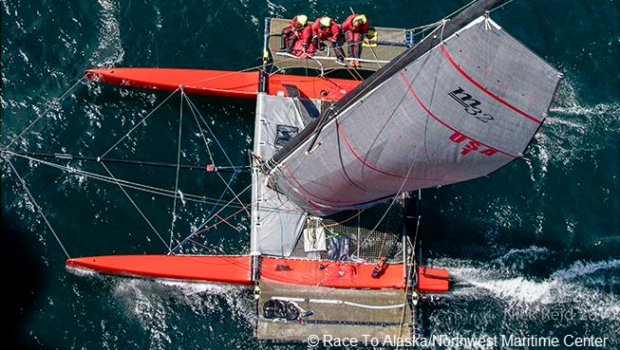


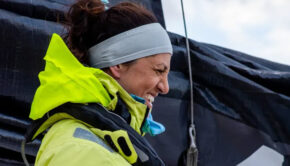
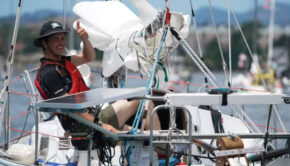
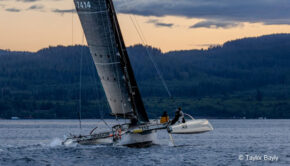
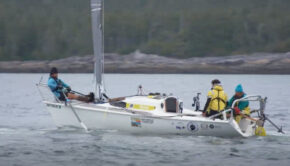
 We’ll keep your information safe.
We’ll keep your information safe.